Botanical Research
Vol.
07
No.
06
(
2018
), Article ID:
27619
,
8
pages
10.12677/BR.2018.76068
The Establishment of the Rapid Propagation System of Cold Resistance Gloxinia
Qing Kong, Yuchen Li, Wei Zhao, Huile Qiu, Haoyu Zhang, Xiaojian Yang*
Shandong Medicine Technician College, Taian Shandong

Received: Oct. 26th, 2018; accepted: Nov. 12th, 2018; published: Nov. 19th, 2018

ABSTRACT
[Objective]: The ornamental flower Gloxinia is a perennial bulbous herb, but its seeds are difficult to reproduce and barely cold-resista. So it is necessary to study the rapid propagation system of cold-resistant Gloxinia. [Methods]: Laboratory of Professor Wang Xiaoyun in Shandong Agricultural University has just obtained transgenic Gloxinia with cold tolerance gene. By using this experimental material, a rapid propagation system of cold tolerant Gloxinia was established. [Results]: The results showed that the explants with small buds and lobules produced more buds than those with leaves and stems. MS with 15 g/L sugar and 0.1 mg/L NAA as the proliferation medium was better than MS + 15 g/L sugar + 0.2 mg/L NAA or MS + 15 g/L sugar + 0.1 mg/L NAA + 0.5 mg/L 6-BA. The rooting medium with 1/2MS + 30 g/L sugar + 0.2 mg/L NAA was the shortest rooting medium. [Conclusion]: The optimum rapid propagation system of transgenic Gloxinia with AtCBF1 cold tolerance regulation gene is MS + 15 g/L sugar + 0.1 mg/L NAA medium with small buds and lobules as explants.
Keywords:Gloxinia, Rapid Propagation System, Explant, Hormone Concentration
抗寒大岩桐快速繁殖体系的建立
孔青,李雨晨,赵炜,仇会乐,张浩宇,杨晓健*
山东医药技师学院,山东 泰安

收稿日期:2018年10月26日;录用日期:2018年11月12日;发布日期:2018年11月19日

摘 要
[目的]:观赏花卉大岩桐为多年生球根草本花卉,但其种子繁殖困难且不耐寒。因此,研究抗寒大岩桐快速繁殖体系非常有必要。[方法]:山东农业大学王晓云教授实验室刚获得转耐寒基因大岩桐植株,利用该实验材料,建立了耐寒大岩桐的快速繁殖体系。[结果]:发现以小芽带小叶为外植体比以叶片和茎段为外植体出芽多,以MS + 15 g/L糖 + 0.1 mg/L NAA为增殖培养基比MS + 15 g/L糖 + 0.2 mg/L NAA或者MS + 15 g/L糖 + 0.1 mg/L NAA + 0.5 mg/L 6-BA增殖速度快。并且,以1/2MS + 30 g/L糖 + 0.2 mg/L NAA为生根培养基,最易在短时间内获得大量生根植株。[结论]:带有AtCBF1抗寒调控基因的转基因大岩桐最佳快速繁殖体系为以小芽带小叶为外植体,以MS + 15 g/L糖 + 0.1 mg/LNAA为增殖培养基。
关键词 :大岩桐,快速繁殖体系,外植体,激素浓度

Copyright © 2018 by authors and Hans Publishers Inc.
This work is licensed under the Creative Commons Attribution International License (CC BY).
http://creativecommons.org/licenses/by/4.0/


1. 引言
大岩桐(Sinningia speciosa)又称落雪泥,原产巴西,一般作温室培养 [1]。大岩桐是苦苣苔科大岩桐属多年生球根草本花卉,块茎扁球形,地上茎极短,株高可达25 cm,全株密被白色绒毛,叶片对生,花顶生或腋生 [2]。中国大岩桐的引种主要在20世纪30年代,由在南京的金陵大学农学院和中山陵园纪念植物园从美国引进,新中国成立后各地植物园才正式引种试种 [3]。
关于大岩桐快速繁殖体系的建立,我们可以检索到的相关研究较少 [4]。徐全乐等采用其的叶片、叶柄和根外植体建立了两种高效离体再生体系 [5]。第1种是:外植体先形成愈伤组织再分化出不定芽,然后再生成不定根,进而形成再生苗;第2种方法是:外植体先形成少量愈伤组织和根,再产生不定芽,进而形成再生苗 [6]。李淑芹等探讨了重瓣大岩桐工厂化育苗的技术要求、生产计划的制定、生产成本、经济效益概算等,以及简要的温室成苗的栽培管理要求 [7]。尹智慧等认为不同激素组合对不定芽的诱导效果差异显著,叶片不定芽的诱导和增殖的最佳培养基均为MS + 1.0 mg/L 6-BA + 0.1 mg/L NAA,生根适宜培养基1/2MS + 0.5mg/L NAA,大岩桐叶片对卡那霉素的敏感浓度为200 mg/L。
大岩桐喜温暖,湿润,半荫,忌强光直射和富含腐殖质的疏松,肥沃偏酸性沙质土壤环境生长,不耐低温,5℃以下难以越冬,气温下降到5℃左右时休眠,气温过高也会影响植株正常生长,生长适温10℃~25℃,不同季节又有不同的要求,1~10月间为18℃~25℃,10月到第2年的1月10℃~12℃;培育抗寒品种有望实现非温室越冬,扩大种植面积,降低生产成本 [8] [9]。大岩桐播种后160~210 d开花,营养生长期较长,培育早花品种,可提早上市,提高商业价值。本课题拟探究山东农业大学培育的带有AtCBF1抗寒调控基因的转基因大岩桐的快速繁殖体系。
2. 材料与方法
2.1. 材料与试剂
转基因抗寒大岩桐由山东农业大学作物生物学国家重点实验室王晓云教授实验室提供。
2.2. 方法
1) 诱导分化培养基以MS为基本培养基,琼脂8 g/L,添加不同浓度的6-BA、NAA和蔗糖,pH调至5.8。培养基激素处理浓度为继代培养基(1) MS + 15 g/L糖 + 0.1 mg/L NAA,(2) MS + 15 g/L糖 + 0.2 mg/L NAA,(3) MS + 15 g/L糖 + 0.1 mg/L NAA + 0.5 mg/L 6-BA,(4) MS + 30 g/L糖 + 0.1 mg/L NAA。
2) 工作台用酒精擦拭一遍,紫外照射30分钟,打开风机,点燃酒精灯,手术刀、镊子在酒精灯上消毒晾凉。外植体分别选择叶片(0.5 cm2、1 cm2)、茎段、小芽带小叶。每瓶接种5~8个外植体,放入不同激素浓度处理的培养基。培养温度为25℃,每天需要光照8~10小时。
定期统计出芽和生长情况,确定最佳培养基。
3) 然后放入生根培养基(5) MS + 30 g/L糖 + 0.2 mg/L NAA。20天全部生根,开盖炼苗,移入小盆,将小苗插入在湿沙土中,注意不要放在太阳下面直射。
3. 结果与分析
3.1. 不同外植体增殖效果
我们选用同样的培养基(1) MS + 15 g/L糖 + 0.1 mg/L NAA,接种不同的外植体,如小叶片(如图1①)、大叶片(如图1②)、茎段(如图1③)、小芽带小叶(如图1④)。
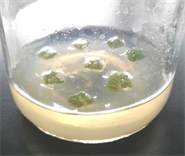 ①
①  ②
②  ③
③  ④
④
Figure 1. Inoculation of different explant (① 0.5 cm2 lobules, ② 1 cm2 lobules, ③ stems, ④ small buds and lobules)
图1. 不同外植体接种图(图①为小叶片0.5 cm2、图②大叶片1 cm2、图③为茎段、图④为小芽带小叶)
接种21天后观察发现以茎段为外植体长得比较慢,变化不大(如图2①);以叶片为外植体只长出很细的茎(如图2②);而小芽带叶长势最好(如图2③)。


Figure 2. Proliferation of different explants after 21 days’ inoculation (① stem-explant, ② leaf-explant, ③ stem-leaf-explant; 1 and 2 were shot in different angles)
图2. 接种21天后不同外植体增殖图(①为以茎段为外植体,②为以叶片为外植体,③为以茎加小叶为外植体;1和2是从不同角度拍摄的)
接种38天后观察发现以茎段为外植体长出叶片颜色较深,但是出芽较少(如图3①);以叶片为外植体仍然只长出很多小茎(如图3②);依然是小芽带叶为外植体长势最好(如图3③)。
 ①
①  ②
② 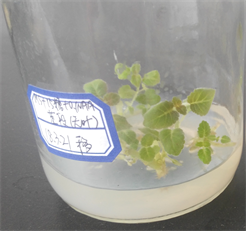 ③
③
Figure 3. Proliferation of different explants after 38 days’ inoculation (① stem-explant, ② leaf-explant, ③ stem-leaf-explant)
图3. 接种38天后不同外植体增殖图(①为以茎段为外植体,②为以叶片为外植体,③为以小芽加小叶为外植体)
由此可以看出,以小芽加小叶为外植体,出芽最多,增殖效果最好。
3.2. 不同浓度NAA处理结果
根据2.1结果,在后续实验中我们选择小芽带小叶为外植体。将同样大小的外植体接种到继代培养基(1) MS + 15 g/L糖 + 0.1 mg/L NAA (如图4①)和(2) MS + 15 g/L糖 + 0.2 mg/L NAA中(如图4②)。
接种21天后观察发现,接种至继代培养基(1) NAA 0.1 mg/L的外植体出芽较多(如图5①③),而继代培养基(2) NAA 0.2 mg/L上的外植体出芽少(如图5②④)。
 ①
① ②
②
Figure 4. The inoculation of same explants in the medium with different NAA concentrations (① inoculation of stem-leaf-explant in subculture medium (1) MS with 15 g/L sugar and 0.1 mg/L NAA, ② inoculation of stem-leaf-explant in subculture medium (2) MS with 15 g/L sugar and 0.2 mg/L NAA)
图4. 相同外植体接种在不同NAA浓度的培养基上(图①为小芽带叶接种至继代培养基(1) MS + 15 g/L糖 + 0.1 mg/L NAA;图②为小芽带叶接种至继代培养基(2) MS + 15 g/L糖 + 0.2 mg/L NAA)

Figure 5. The proliferations in medium with different concentrations of NAA after 21 days’ inoculation (①③ the proliferation in subculture medium (1) with 0.1 mg/L NAA in different vision, ② ④ the proliferation in subculture medium (2) with 0.2 mg/L NAA in different vision)
图5. 接种21天后不同NAA浓度培养基上增殖情况(① ③为不同拍摄角度继代培养基(1) NAA 0.1 mg/L上增殖情况,② ④为不同拍摄角度继代培养基(2) NAA 0.2 mg/L上增殖情况)
接种38天后观察发现接种至继代培养基(1) NAA 0.1 mg/L的外植体出芽较多,叶片较小且翠绿(如图6①);而继代培养基(2) NAA 0.2 mg/L上的外植体出芽少,叶片较大呈墨绿色(如图6②)。
 ①
① ②
②
Figure 6. The proliferations in medium with different concentrations of NAA after 38 days’ inoculation (① the proliferation in subculture medium (1), ② the proliferation in subculture medium (2))
图6. 接种38天后不同NAA浓度培养基增殖情况(①为继代培养基(1)上增殖情况,②为继代培养基(2)上增殖情况)
由此可以看出,培养基中NAA浓度为0.2 mg/L,出芽最较多,增殖效果最好。
3.3. 不同浓度6-BA处理结果
根据2.1结果,在后续实验中我们选择小芽带叶为外植体。将同样大小的外植体接种到继代培养基(1) MS + 15 g/L糖 + 0.1 mg/L NAA和(3) MS + 15 g/L糖 + 0.1 mg/L NAA + 0.5 mg/L 6-BA (如图7)。
 ①
① ②
②
Figure 7. The inoculations of same explants in the medium with different 6-BA concentrations (① the inoculation of the small buds and lobules in the subculture medium (1) MS + 15 g/L sugar + 0.1 mg/L NAA, ② the inoculation of the small buds and lobules in the subculture medium (3) MS + 15 g/L sugar + 0.1 mg/L NAA + 0.5 mg/L 6-BA)
图7. 相同外植体接种在不同6-BA浓度的培养基上(图①为小芽带叶接种至继代培养基(1) MS + 15 g/L糖 + 0.1 mg/L NAA;图②为小芽带叶接种至继代培养基(3) MS + 15 g/L糖 + 0.1 mg/L NAA + 0.5 mg/L 6-BA)
21天后观察发现,接种至继代培养基(1)无6-BA的外植体出芽多且叶片为嫩绿色,而继代培养基(3) 0.5 mg/L 6-BA上的外植体出芽同样比较多,但是叶片生长缓慢(如图8)。
 ①
①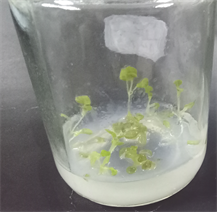 ②
②
Figure 8. The proliferation in medium with different concentrations of 6-BA after 21 days’ inoculation (①the proliferation in subculture medium (1), ② the proliferation in subculture medium (3))
图8. 接种21天后不同6-BA浓度培养基增殖情况(①为继代培养基(1)上增殖情况,②为继代培养基(3)上增殖情况)
38天后观察发现,同21天时观察结果相似,接种至继代培养基(1)无6-BA的外植体出芽多且叶片为嫩绿色,而继代培养基(3)0.5mg/L 6-BA上的外植体出芽同样比较多,但是叶片生长及其缓慢(如图9)。
3.4. 不同浓度蔗糖处理结果
根据2.1结果,在后续实验中我们选择小芽带叶为外植体。将同样大小的外植体接种到继代培养基(1) MS + 15 g/L糖 + 0.1 mg/L NAA和(4) MS + 30 g/L糖 + 0.1 mg/L NAA (如图10)。
 ①
① ②
②
Figure 9. The proliferation in medium with different concentrations of 6-BA after 38 days’ inoculation (①the proliferation in subculture medium (1), ② the proliferation in subculture medium (3))
图9. 接种38天后不同6-BA浓度培养基增殖情况(①为继代培养基(1)上增殖情况,②为继代培养基(3)上增殖情况)
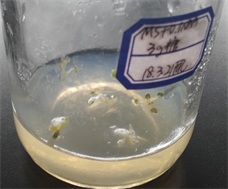 ①
① ②
②
Figure 10. The inoculation of same explants in the medium with different sugar concentrations (① the inoculation of stem-leaf-explant in subculture medium (1) MS with 15 g/L sugar and 0.1 mg/L NAA, ② the inoculation of stem-leaf-explant in subculture medium (4) MS with 30 g/L sugar and 0.1 mg/L NAA)
图10. 相同外植体接种在不同蔗糖浓度的培养基上(图①为小芽带叶接种至继代培养基(1) MS + 15 g/L糖 + 0.1 mg/L NAA;图②为小芽带叶接种至继代培养基(4) MS + 30 g/L糖 + 0.1 mg/L NAA
21天后观察发现,接种至继代培养基(1) 15 g/L糖的外植体出芽多,而继代培养基(4) 3 g/L糖上的外植体虽然叶片生长较快,但是出芽较少(如图11)。
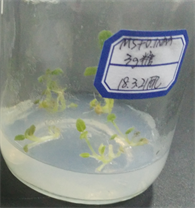 ①
① ②
②
Figure 11. The proliferation in medium with different concentrations of sugar after 21 days’ inoculation (① the inoculation of stem-leaf-explant in subculture medium (1) MS with 15 g/L sugar and 0.1 mg/L NAA, ② the inoculation of stem-leaf-explant in subculture medium (4) MS with 30 g/L sugar and 0.1 mg/L NAA)
图11. 接种21天后不同蔗糖浓度培养基增殖情况(图①为小芽带叶接种至继代培养基(1) MS + 15 g/L糖 + 0.1 mg/L NAA;图②为小芽带叶接种至继代培养基(4) MS + 30 g/L糖 + 0.1 mg/L NAA
38天后观察发现,接种至继代培养基(1) 15 g/L糖的外植体出芽多且叶片为嫩绿色,而继代培养基(3) 30 g/L糖上的外植体虽然叶片生长较快为墨绿色,但是出芽较少。另外,我们发现蔗糖为30 g/L时会生根,因此,在后续实验中,我们以此培养基为生根培养基(如图12)。
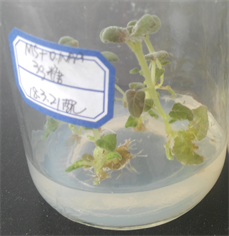 ①
① ②
②
Figure 12. The proliferation in medium with different concentrations of sugar after 38 days’ inoculation (① the inoculation of stem-leaf-explant in subculture medium (1) MS with 15 g/L sugar and 0.1 mg/L NAA, ② the inoculation of stem-leaf-explant in subculture medium (4) MS with 30 g/L sugar and 0.1 mg/L NAA)
图12. 接种38天后不同蔗糖浓度培养基增殖情况(图①为小芽带叶接种至继代培养基(1) MS + 15 g/L糖 + 0.1 mg/L NAA;图②为小芽带叶接种至继代培养基(4) MS + 30 g/L糖 + 0.1 mg/L NAA)
4. 结论
综上所述,若想快速繁殖大岩桐,可以以小芽带小叶为外植体,以MS + 15 g/L糖 + 0.1 mg/L NAA为增殖培养基,以1/2MS + 30 g/L糖 + 0.2 mg/L NAA为生根培养基。
文章引用
孔 青,李雨晨,赵 炜,仇会乐,张浩宇,杨晓健. 抗寒大岩桐快速繁殖体系的建立
The Establishment of the Rapid Propagation System of Cold Resistance Gloxinia[J]. 植物学研究, 2018, 07(06): 558-565. https://doi.org/10.12677/BR.2018.76068
参考文献
- 1. 苏江, 岑忠用, 谢彦军, 邓晰朝, 高丽霞, 韦兆杰. 大岩桐组培苗移栽后生长动态研究[J]. 种子, 2018, 37(6): 82-85 + 92.
- 2. 周淑荣, 郭文场, 刘佳贺. 大岩桐栽培管理[J]. 特种经济动植物, 2017, 20(8): 30-31.
- 3. 闫海霞, 蒋月喜, 何荆洲, 邓杰玲, 黄昌艳, 王晓国, 卜朝阳. 重瓣大岩桐离体培养的两种途径[J]. 江西农业学报, 2016, 28(11): 30-34.
- 4. 费元, 韩雪, 余红, 庞基良. 大岩桐花萼和幼叶转录组研究[J]. 园艺学报, 2015, 42(12): 2519-2525.
- 5. 郭丽, 朱飞雪, 贾文庆. 大岩桐高频再生体系的研究[J]. 江苏农业科学, 2015, 43(5): 51-53 + 356.
- 6. 徐全乐, 谢亚红, 刘文婷, 等. 大岩桐高频再生体系建立的两种途径[J]. 园艺学报, 2010, 37(1): 135-140.
- 7. 李淑芹. 重瓣大岩桐(Sinningia speciosa)组织培养及工厂化育苗技术的研究[D]: [硕士学位论文]. 哈尔滨: 东北林业大学, 2004.
- 8. 李达. 大岩桐再生体系的建立及遗传转化的研究[D]: [硕士学位论文]. 泰安: 山东农业大学, 2013.
- 9. Hu, Z., Li, C., Wang, X., et al. (2009) Tissue Culture of Sinningia speciosa and Analysis of the in Vitro-Generated Tricussate Whorled Phyllotaxis (twp) Variant. In Vitro Cellular & Developmental Biolo-gy-Plant, 45, 583. https://doi.org/10.1007/s11627-009-9257-z
NOTES
*通讯作者。